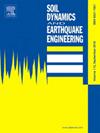深层大气共振器的环境振动
IF 4.2
2区 工程技术
Q1 ENGINEERING, GEOLOGICAL
引用次数: 0
摘要
我们介绍了用于识别和描述玛珥沉积填充物的非侵入式地震方法。我们进行了密集的环境振动勘测,并采用了最先进的三维共振分析技术来绘制沉积层的横向范围和深度,由于不利的纵横比(深度>;横向维度),这是传统地球物理方法所面临的挑战。由于火山口填充物的三维共振,火山口的环境振动主要由正常模式运动驱动。通过密集的站点覆盖,可以获得法向模态形状的详细图像,从而揭示填充物的对称性。共振导致了地面运动的极度放大,垂直分量的放大系数高达 30,这对传统的场地效应观念和基于广泛使用的水平与垂直频谱比的方法提出了挑战。这些结果得到了玛珥地震响应数值模拟的支持。观测到的反应非常具体,可用来在现场识别部分被侵蚀的 maar 结构。本文章由计算机程序翻译,如有差异,请以英文原文为准。
Ambient vibrations of a deep maar resonator
We introduce non-invasive seismic methods for identifying and characterizing maar sedimentary infills. We conducted a dense ambient vibration survey and employed state-of-the-art 3D resonance analysis techniques to map the lateral extent and depths of the sedimentary layers, a challenge with traditional geophysical methods due to unfavorable aspect ratios (depth > lateral dimension). The ambient vibrations of maars are predominantly driven by normal mode motions due to 3D resonance of crater infills. Dense station coverage enabled detailed images of the normal mode shapes revealing infill symmetries. The resonance results in extreme ground motion amplification, with factors reaching up to 30 on the vertical component, challenging conventional beliefs about site effects and methodologies based on widely used horizontal-to-vertical spectral ratios. These results are supported by numerical simulations of the maar's seismic response. The observed response is so specific that it can be used to identify partly eroded maar structures in the field.
求助全文
通过发布文献求助,成功后即可免费获取论文全文。
去求助
来源期刊

Soil Dynamics and Earthquake Engineering
工程技术-地球科学综合
CiteScore
7.50
自引率
15.00%
发文量
446
审稿时长
8 months
期刊介绍:
The journal aims to encourage and enhance the role of mechanics and other disciplines as they relate to earthquake engineering by providing opportunities for the publication of the work of applied mathematicians, engineers and other applied scientists involved in solving problems closely related to the field of earthquake engineering and geotechnical earthquake engineering.
Emphasis is placed on new concepts and techniques, but case histories will also be published if they enhance the presentation and understanding of new technical concepts.
 求助内容:
求助内容: 应助结果提醒方式:
应助结果提醒方式:


